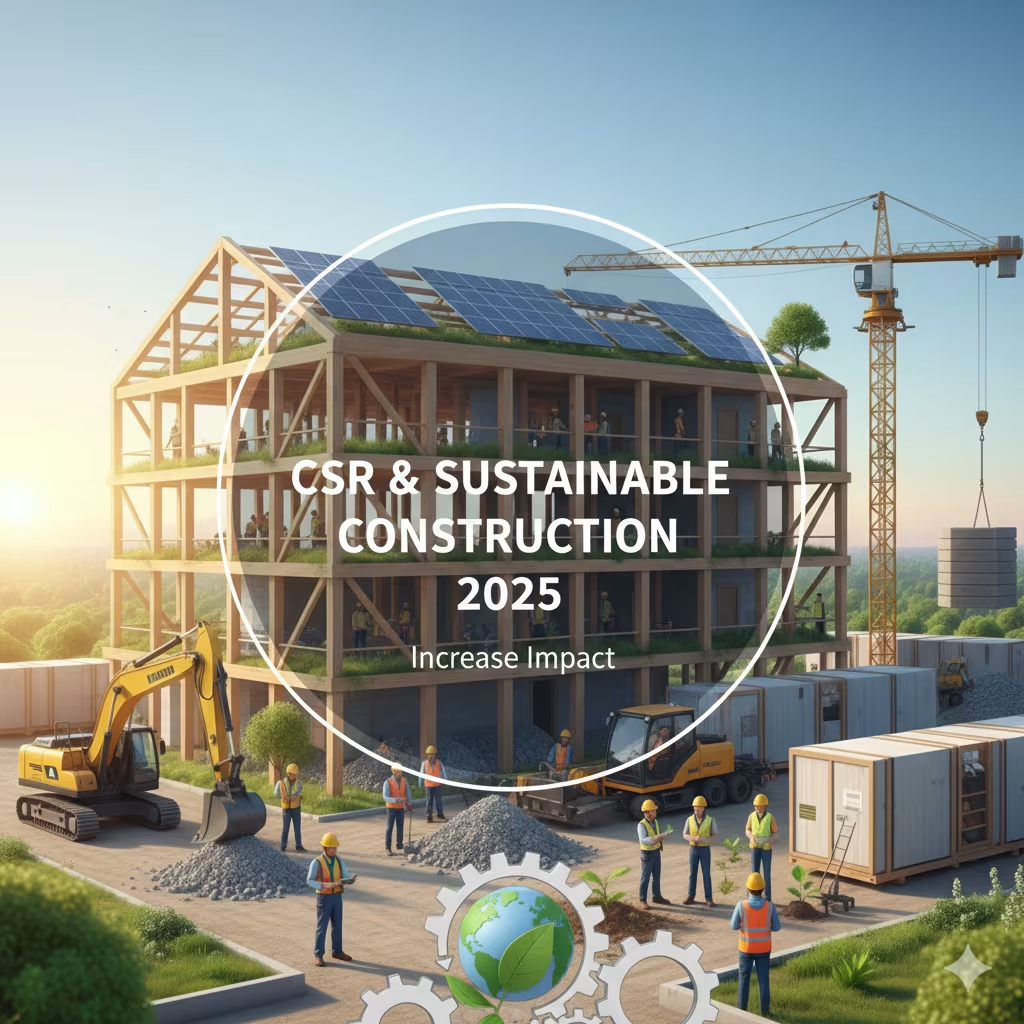How to Increase CSR Impact with Sustainable Construction in 2025

Table of content
India Inc. hit a record ₹34,909 crore CSR spend in FY 2023–24, creating a massive opportunity to shift from “build & forget” to build once, save forever through green design and operations. (Fortune India)
At the same time, regulatory expectations are rising: impact assessments are mandatory for companies with an average CSR obligation ≥ ₹10 crore and for projects ≥ ₹1 crore—so measurable outcomes (like verified energy/water savings) aren’t a “nice to have”; they help you comply. (Ministry of Coal)
For CSR-funded schools, hospitals, skill centers, and community buildings, sustainable construction means creating infrastructure that reduces lifetime energy and water use, lowers O&M costs, and delivers healthier, more comfortable spaces for communities.
In India, three major certification frameworks make these benefits measurable and auditable:
- IFC EDGE – Requires at least 20% savings in energy, water, and embodied energy in materials compared to a local baseline. EDGE is widely used in India because it is quick to model, cost-effective, and provides clear ROI math. (EDGE Buildings)
- IGBC – Green New Buildings – Typically delivers 20–30% energy savings through better building envelope, lighting, and HVAC efficiency. IGBC is among the most recognized green labels in India, backed by CII. (Indian Green Building Council)
- GRIHA (incl. v2019) – India’s national green rating system, aligned with the National Building Code (NBC 2016) and Energy Conservation Building Code (ECBC 2017). It evaluates performance across energy, water, materials, waste, and O&M, making it ideal for CSR and public infrastructure. (GRIHA India)
Why certifications matter for CSR
These certifications do more than save costs—they:
- Standardize baselines for impact measurement.
- Provide verifiable metrics (kWh, m³ water, CO₂ avoided) that feed directly into CSR board reports, ESG disclosures, and MCA-mandated impact assessments. (Ministry of Corporate Affairs – CSR Rules)
1) Lower operating costs = more program funds every year
- Energy savings: Green buildings in India typically cut energy use by 20–30% compared to conventional designs, and savings can be even higher with advanced efficiency measures. (IGBC)
- Water savings: EDGE and GRIHA projects consistently achieve 20–30%+ water reduction, and many exceed 40% with rainwater harvesting, low-flow fixtures, and greywater reuse. (EDGE Buildings, GRIHA)
These savings mean lower electricity and water bills every year, freeing up CSR funds for scholarships, medicines, or community programs.
2) Faster payback than you think
- The incremental cost of going green has dropped significantly in India—often just 2–3% extra if planned early.
- Case studies and CII/IGBC industry forums report payback within ~18–24 months, thanks to reduced energy and water bills. (CII–IGBC, Times of India)
In simple terms, a modest upfront investment pays for itself quickly, then keeps generating savings for decades.
3) Stronger compliance & credibility
- EDGE, IGBC, and GRIHA certifications provide auditable, transparent savings data—kWh, m³ water, and CO₂ avoided.
- These outputs align directly with MCA’s CSR impact assessment requirements, making reporting easier and more credible. (MCA CSR Rules)
Certifications turn your CSR project into a measurable, reportable impact story—strengthening ESG disclosures, board presentations, and public trust.
When presenting sustainable construction in CSR projects, boards want numbers they can trust. Here’s a straightforward ROI framework:
1. Baseline Annual Cost (Conventional Design)
Formula:
(Annual kWh × Tariff) + (Annual water m³ × Water tariff) + O&M
This gives you the expected operating cost of a conventional (non-green) building.
2. Savings % (Conservative Benchmarks)
- Energy savings: 20–25% (EDGE/IGBC typical range) (EDGE Buildings, IGBC)
- Water savings: 25–40% (EDGE minimum 20%; GRIHA and municipal guidelines often higher with reuse strategies) (GRIHA)
3. Annual Savings (₹)
Formula:
Baseline annual cost × Weighted savings %
This converts efficiency gains into recurring cash flow that can be redirected into scholarships, medicines, or community programs.
4. Incremental “Green” Capex
- Typical extra cost: 1–3% of project cost (if planned early in design).
- Payback formula:
Payback (years) = Incremental capex ÷ Annual savings
Many Indian case studies report ~18-month payback, after which the savings continue for the life of the building. (Times of India)
5. Worked Example (Hospital OPD Block)
- Baseline electricity: ₹1.0 crore/year
- Baseline water: ₹15 lakh/year
Adopting EDGE/IGBC measures with 25% energy savings + 30% water savings gives:
- Energy savings = ₹25 lakh/year
- Water savings = ₹4.5 lakh/year
- Total annual savings = ₹29.5 lakh
If incremental green cost is ₹45 lakh (~2–3% on a ₹15–20 crore block), then:
- Payback = ~1.5 years
- After that, savings compound annually, funding free medicines, diagnostics, or scholarships for the community.
These are high-leverage, budget-friendly moves for CSR assets:
- Passive first: orientation, shading, high-performance glass, roof insulation; daylit corridors/classrooms/wards. (Locks in permanent energy cuts before you buy equipment.) (Indian Green Building Council)
- Efficient systems: right-sized HVAC, high-efficiency fans/pumps/chillers, LED + controls, VFDs. (Indian Green Building Council)
- Water strategy: low-flow fixtures, dual-flush, rainwater harvesting, greywater reuse for flushing/landscape. (EDGE Buildings)
- Materials: locally available, low-embodied energy choices; EDGE tracks embodied energy to meet the 20% threshold. (EDGE Buildings)
- O&M by design: metering, dashboards, and SOPs that keep savings real after handover (supports impact assessments). (Ministry of Coal
Q1. How conservative should we be in savings claims?
Use 20–25% energy and 25–30% water as default; show ranges and cite your certification framework (EDGE/IGBC). (EDGE Buildings)
Q2. What about incremental capex?
If design is optimized early, many Indian projects report ~2–3% extra cost and ~18-month payback due to lower OPEX. (The Times of India)
Q3. Can this help our ESG reports?
Yes—certification tools quantify kWh, m³, and embodied energy/CO₂; those KPIs flow into ESG/impact disclosures. (EDGE Buildings)
India’s CSR spend hit ₹34,909 crore in FY24, but true impact comes from building once and saving forever. With sustainable construction, corporates can achieve 20–30% energy and 25–40% water savings, ensuring compliance and freeing funds for medicines, scholarships, and community programs.
From a CSR hospital in Delhi to a green school in Assam, BuiltX helps turn CSR investments into auditable, world-class projects.
Ready to double your CSR impact? Partner with us, and choose BuiltX as your construction partner.

.avif)